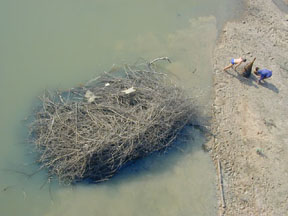11.6 REHABILITATION/ENHANCEMENT OF
FISH POPULATIONS
Fisheries enhancement involves altering
the environment in such a way as to improve certain aspects of the fishery
above and beyond that which would occur naturally. This activity is also
based upon ecological principles. The techniques are often similar to
those employed in restoration/rehabilitation.
Where fish populations have become depleted in a river or reservoir, populations
can be restored by stocking or by reintroduction of species that have
been eliminated.
Stocking is seen as a regular method for managing fish stocks and is widely
used in the Mekong basin, especially to sustain the productivity of selected
species in reservoirs. Both practices have their dangers.
Introductions are now generally discouraged as introduced species can
replace native species by competition or predation and become a severe
nuisance. They can also introduce diseases. For this reason, official
permission has to be sought before any introduction is made.
Stocking can also cause difficulties in that putting large numbers of
a preferred species into a river or lake can disturb the natural balance
of fish populations. Also, stocking with fish of inappropriate origin
can damage the genetic composition of the receiving fish stock. For this
reason, proposals to stock fish should be made according to strict guidelines
on the origin, and the quantity and quality of the fish to be stocked.
Other commonly used enhancement techniques include:
Planting vegetation in wetlands to attract fish, waterfowl and other aquatic organisms, and to boost production (providing extra feeding and breeding areas)
Extending the duration of flooding of wetlands in order to extend the production period (in areas where flood management is possible)
Removal of unwanted or "nuisance" species in favour of preferred species• predators in particular are often deliberately removed from areas (especially predatory fish and birds) in order to produce more fish for human consumption (this is common, for example, with rice field fisheries)
Introducing nutrients into the ecosystem in order to boost primary productivity (and this is often done on the large scale by deliberately releasing biological wastes such as sewage into swamps, lakes, reservoirs etc.).
Because these "enhancement" techniques can change the ecology of areas beyond that which would occur naturally, some of them, if not properly managed, can lead also to environmental degradation.
 |
This picture shows a 'brush park' in the Songkhram River, Thailand where the local fishers have placed twigs and branches in the water to attract fish and to give them places to feed, breed and hide. This is an example of habitat enhancement or rehabilitation – depending upon whether you consider that it restores natural conditions or creates unnatural ones. |